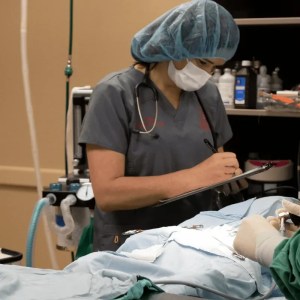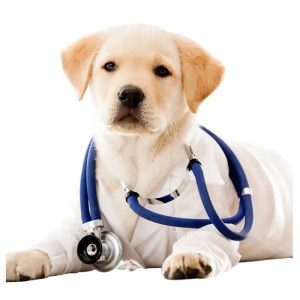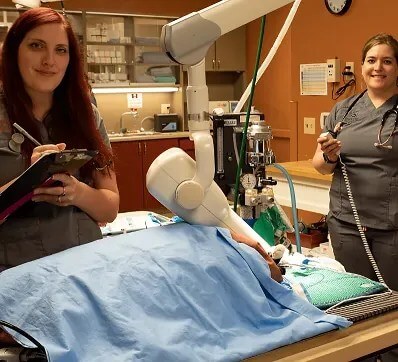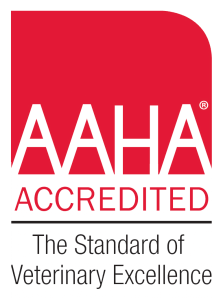Before Your Dog's Upcoming Surgery
Many people have questions about various aspects of their pet’s surgery and we hope the following information will help. It also explains the decisions you will need to make before your upcoming dog surgery.
Should I Feed My Dog Prior to Surgery?
It is important that surgery be done on an empty stomach, to reduce the risk of vomiting during and after the anesthesia. You will need to withhold food for at least 8 hours before surgery. Water can be left out until the morning of surgery.
Is Anesthetic Safe?
 Today’s modern anesthetics and anesthetic monitors have made surgery much safer than in the past. We do a thorough physical exam on your pet before administering anesthetics to ensure that a fever or other illness won’t be a problem. We also adjust the amount and type of anesthetic used depending on the health of your pet. See Anesthesia and Your Pet section; it explains this in greater detail.
Today’s modern anesthetics and anesthetic monitors have made surgery much safer than in the past. We do a thorough physical exam on your pet before administering anesthetics to ensure that a fever or other illness won’t be a problem. We also adjust the amount and type of anesthetic used depending on the health of your pet. See Anesthesia and Your Pet section; it explains this in greater detail.
Pre-Anesthetic Blood Testing Prior to Your Dogs Surgery

is important in reducing the risk of anesthesia. Every pet needs blood testing before surgery to ensure that their liver and kidneys are functioning normally and can handle the elimination of the anesthetic agents given. We check a blood sugar to ensure normal metabolism by the brain, and that the pet is hydrated and has enough red blood cells to carry oxygen to their tissues. The blood is also checked for evidence of infection or inflammation. Even apparently healthy animals can have serious organ system problems that cannot be detected without blood testing. If there is a problem it is much better to find it before it causes anesthetic or surgical complications! In animals that have minor dysfunctions anesthesia may be able to be performed by altering amounts and the type of drugs used. If serious problems are detected, surgery will be postponed until the problem is identified and corrected. We include pre-anesthetic blood testing with every spay and neuter surgery. The cost is included in the price of the surgery.
Dog Surgery Video Script
Dr. Jennifer Bloss:
It’s always a very anxious time for owners when are pet has to undergo anesthesia. Be it for a spay, or a neuter surgery when they’re young, or a dentistry when they’re a little bit older, or a tumor removal. So today, we thought we would show you what happens behind the scenes with your pet to help alleviate some of your anxiety. The morning of your pet’s procedure, you’ll be placed in an exam room, and the doctor will come in and perform a complete physical exam on your pet, and also draw any blood that needs to be done if it hasn’t been done previously. We want to make sure that your pet is completely healthy before it undergoes anesthesia. And we will have you fill out a consent form, and we will go over the risks and the benefits of the procedure that your pet will be having done.
Dr. Jennifer Bloss:
So once you leave for work, and we bring your pet back to our treatment area, the first thing that we’re going to do is calculate a pre-anesthetic injection for them. This medication has an anti-anxiety component to it, and also a pain medication. And this allows us to use less anesthesia for your dog overall, which makes it much safer, and it also makes it a much calmer day for your pet as well. So we are going to be giving Lilly her injection. So this is Molly. She’s my veterinary assistant.
Molly:
Attagirl.
Dr. Jennifer Bloss:
And we’re going to be giving-
Molly:
We have our pre-meds.
Dr. Jennifer B:
Yep, going to be giving Lilly her injection here today. Good girl. See? That wasn’t so bad, was it? Just a little poke. All right. And then your pet will be placed in a kennel a nice, comfy blanket, and we’ll let that medication start to work.
Dr. Jennifer Bloss:
So Lilly has been given her pre-op sedation injection about 20 minutes ago, and you can see she’s very calm right now. She’s very happy. We are going to be placing an IV catheter. This will allow us venous access for your pet. It will allow us to give her her IV medications, more pain medications if she needs, more anesthetic if she needs that, and then also IV fluids because she’s not eating or drinking anything today, and it’ll keep her from getting dehydrated. Also, as you can see here, we have her on a circulating water blanket that’s nice and warm. And this right here is called a bear hugger. This is blowing forced hot air through this pillowcase, and it’s going to keep her nice and toasty warm.
Dr. Jennifer Bloss:
While your pet is under anesthesia, it will be monitored by many people. By a certified veterinary technician, your doctor, and also a veterinary assistant. We’re all here to make sure that your pet stays safe.
Dr. Jennifer Bloss:
When your pet’s procedure is finished, it will recover in one of our recovery cages surrounded by nice warm hot towels. And our veterinary assistants and technicians will continue to monitor your pet until we can extubate it and take out the intubation tube that we use to help your pet breathe. Within usually about 10 to 20 minutes, your pet will be standing, ready to walk outside and go potty after his procedure. And before it goes home, we’ll brush her out and give her a cute bandana. Then she’ll be all ready to go home.
Will My Dog Have Stitches After Surgery?
Not usually. For most surgeries we use absorbable sutures underneath the skin. These will dissolve on-their-own and do not need to be removed later. You will, however, need to keep an eye on the incision for swelling, redness and discharge.
Most dogs do not lick excessively or chew at their incisions, but this is an occasional problem that you will need to watch for. If you notice your pet licking at his or her incision call the hospital immediately for instructions. You may need to bring your pet into the hospital to be fitted for a collar to prevent infection. You will also need to limit your pet’s activity level for a time, and no baths are allowed for 14 days after surgery.
Will My Dog Be In Pain Post Surgery?
Anything that causes pain in people can be expected to cause pain in animals. Dogs may not show the same symptoms of pain as people do – they don’t usually whine or cry – but you can be sure they feel it. We take pain control for our patients very seriously! No pet should be in pain! It is a well-known medical fact that when pain is controlled pets recover faster. Prior to surgery, your pet will receive pain medications, as well as after surgery, as needed. Additionally, pain medications will be dispensed for your pet and should be continued for two to five days after the surgery.
Other Minor Procedures to Consider While Your Dog is Under Anesthesia
While your pet is under anesthesia this is the ideal time to perform other minor procedures which are more easily accomplished when your pet is sleeping. Routinely, your dog’s nails will be trimmed at no charge. You may request that one or more of the following additional procedures be performed.
- Cleaning ears / plucking hair from ear canals
- Removal of retained baby teeth and/or Application of dental Sealant – SANOS
- Implantation of AVID microchip for identification
- X-rays of hips on large breed puppies
Charges for these services can be discussed when you schedule your pet’s surgery, or at the time of drop-off.
The Morning of Your Dog Surgery
The morning of surgery, you will need to have your pet here between 7:30 am – 7:50 am. It will take about 5-10 minutes of time to fill out paperwork and then you will meet briefly with the doctor. We will need a phone number that you can be reached at during that day. When you pick up your pet after surgery you can also plan to spend about 10 minutes with the Certified Veterinary Technician to go over your dog’s home care needs.
We will call you the night before your scheduled surgery appointment to confirm the time you will be dropping your pet off and to answer any questions you might have. In the meantime, please don’t hesitate to call us with any questions about your pet’s health or surgery!
Anesthesia And Your Dog

Many pet owners worry unnecessarily about anesthesia in their pets. Although anesthesia can never be completely free of risk, today’s modern anesthetics make that risk very small.
The same anesthetics that allow complicated surgeries such as heart and kidney transplants to be done on humans are used in pets as well. Even very frail animals can usually be anesthetized safely. In general, the risks from NOT performing a needed procedure, such as dental cleaning or tumor removal, are much higher than the risk from the anesthesia.
We use pre-operative blood tests and occasionally other tests such as radiographs (X-rays) to help us determine whether a procedure will be safe for your pet before it is performed. We require pre-operative blood work including a complete blood count, blood chemistries, and total T4 thyroid level for all pets over the age of seven years before anesthesia is administered. Chest X-rays are taken if there is any suspicion of heart or lung disease, or if certain types of cancer have been diagnosed to check for the spread of the disease.
Anesthesia is always and only administered by certified and licensed veterinary technicians or doctors to ensure safety and proper dosing. An IV catheter will be placed prior to surgery. Your pet will receive drugs and fluids through this route. Throughout anesthesia your pet will be monitored closely by a Certified Veterinary Technician (CVT). Blood oxygen and CO2 levels, heart and respiratory rate, body temperature, blood pressure, and heart rhythm (ECG) are monitored every five minutes throughout the surgery.
With proper care and monitoring, your pet should go home after anesthesia just as perky and healthy as when it arrived at the hospital, whether it is 16 months or 16 years of age.
If you have further concerns about anesthesia in your pet, we would be happy to discuss the risks and benefits of any procedure with you and explain the exact protocol that will be used. Please let us know!
Contact Us to Learn More!
We would be happy to discuss any questions you may have pre and post-surgery. Contact us today!


